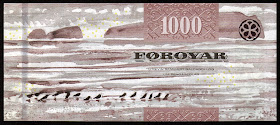Faroese Banknotes 1000 Krone banknote 2011
Obverse: The 1000-krone banknote shows a fragment of a purple sandpiper printed in intaglio. Behind it is a watercolour of a flock of birds.
Reverse: The motif on the reverse is a water colour from the island of Sandoy. Birds are part of the motif, as they are on the face of the banknote.
Signatures of Dan Michael Knudsen and Aksel Vilhelmsson Johannesen. Wide windowed security thread at right on front. One 7-digit horizontal serial number at upper left on front and another one with 6 digits at lower left on front. OMRON-rings on both sides.
Watermark: Ram's head - Faroes sheep. The Faroes is a breed of domestic sheep native to the Faroe Islands. One of the Northern European short-tailed sheep, it is a small, very hardy breed. "Faeroe islands" means "sheep islands" and this animal is on Faroese coat of arms.
Format: 165 x 72 mm.
Printer: Banknote Printing Works and The Royal Danish Mint, Copenhagen, Denmark.
Faroese banknotes - Currency of the Faroe Islands
2011 Issue
The motifs are inspired by the Faroese landscape and fauna. The faces of the banknotes show fragments of fauna, while the reverse motifs are reproductions of watercolours of Faroese landscapes. The watercolours are by the Faroese artist Zacharias Heinesen. The motifs have been chosen, among other reasons, for their dissimilarity, so that the banknotes are easy to distinguish from each other. The fauna motifs are fragments, which gives the banknotes a vivid appearance. The watercolours lend a special quality of lightness to the banknotes.
50 Kronur 100 Kronur 200 Kronur 500 Kronur 1000 Kronur
Sandoy Island
Sandoy (Danish: Sandø) is the first of the five southern islands that make up the Faroe chain, the fifth biggest of all the Faroe Islands, an autonomous region of the Kingdom of Denmark. As of 2011, the largest population center on the island is the village of Sandur with a population of 599. Other settlements include Skarvanes, Skopun, Skálavík, Húsavík and Dalur.
There are similarly named islands, Sanday in the Orkney Islands, Sanday in the Inner Hebrides and Sandøy in Norway.
Important Bird Areas
The island's surrounding bird cliffs and steep slopes have been identified as an Important Bird Area (IBA) by BirdLife International because of their significance as a breeding site for seabirds, especially northern fulmars (50,000 pairs), Manx shearwaters (5000 pairs), European storm petrels (50,000 pairs), European shags (150 pairs), great skuas (15 pairs), Atlantic puffins (70,000 pairs) and black guillemots (400 pairs). An additional IBA on the island comprises the lowland areas around the village of Sandur, with their moorland and peat bogs, and the lakes Gróthúsvatn, Lítlavatn, Sandsvatn and Stóravatn, because they support 100-150 breeding pairs of whimbrels.

